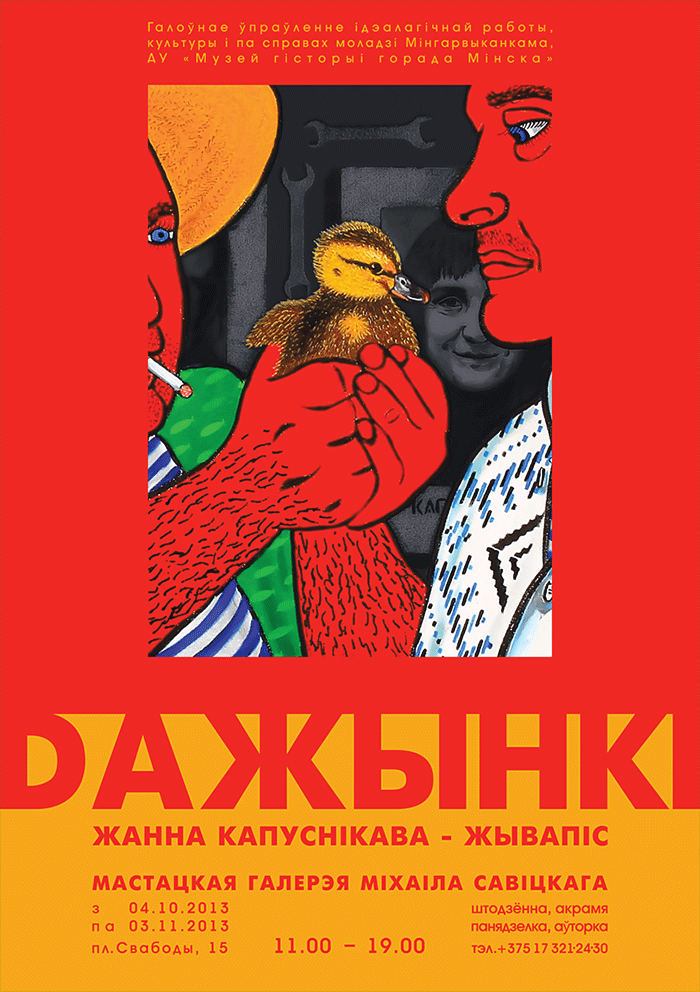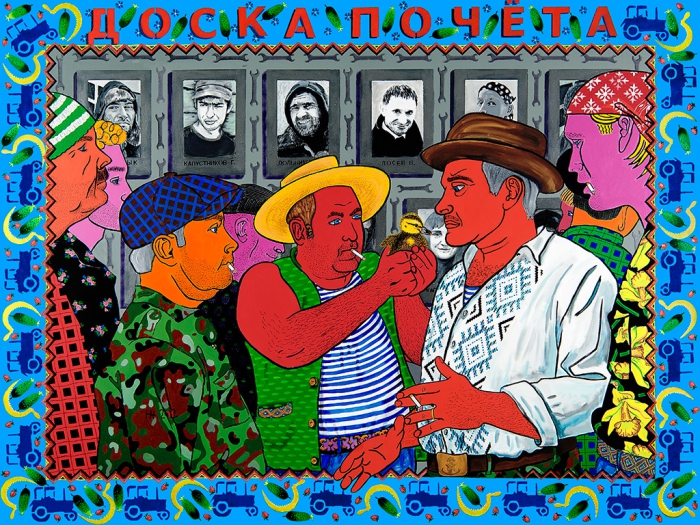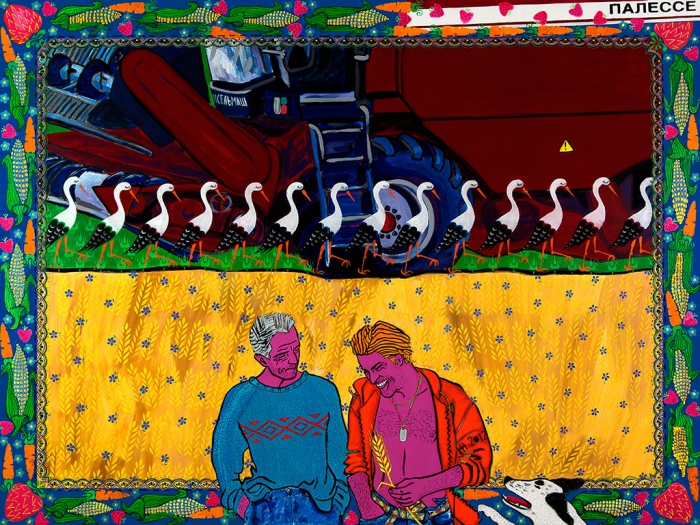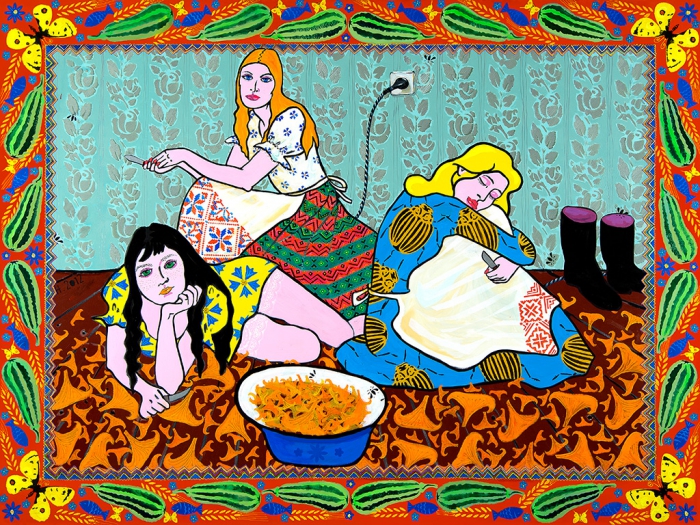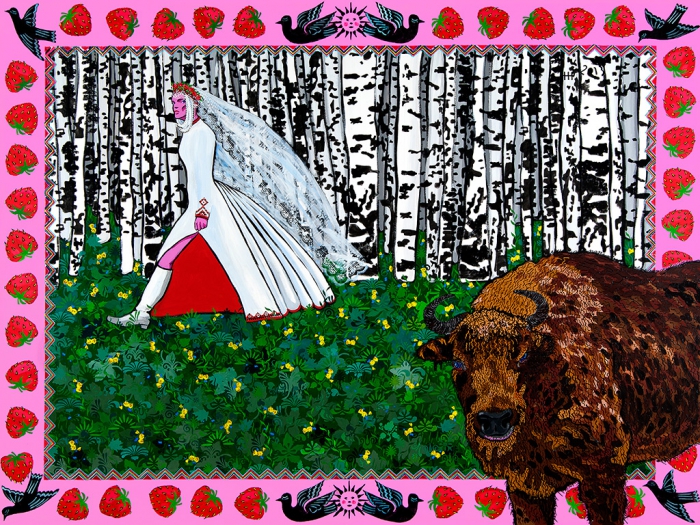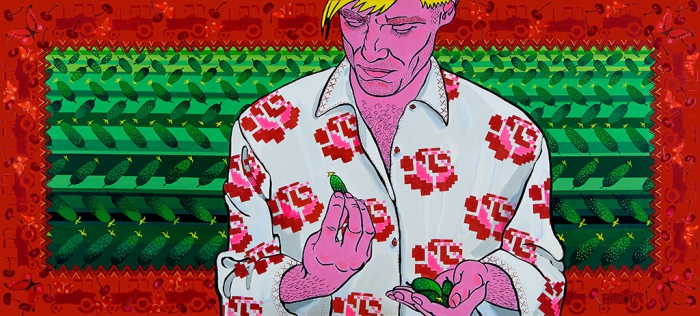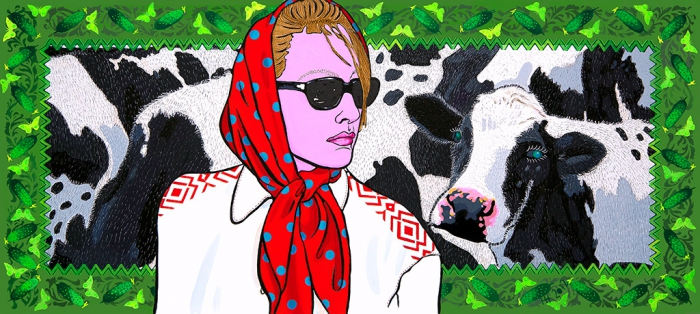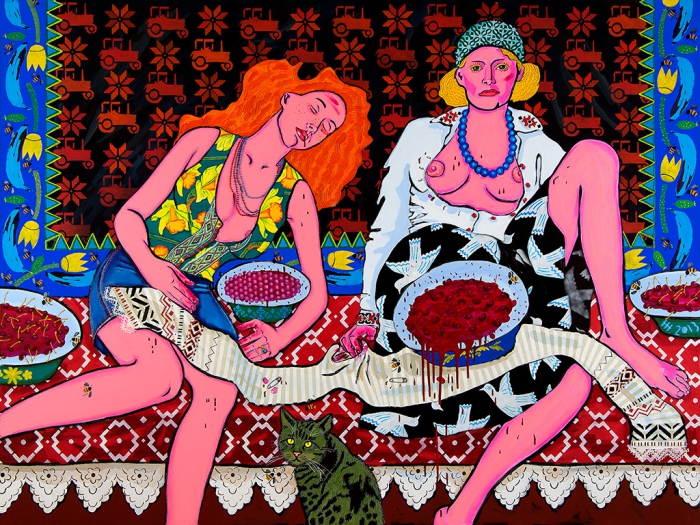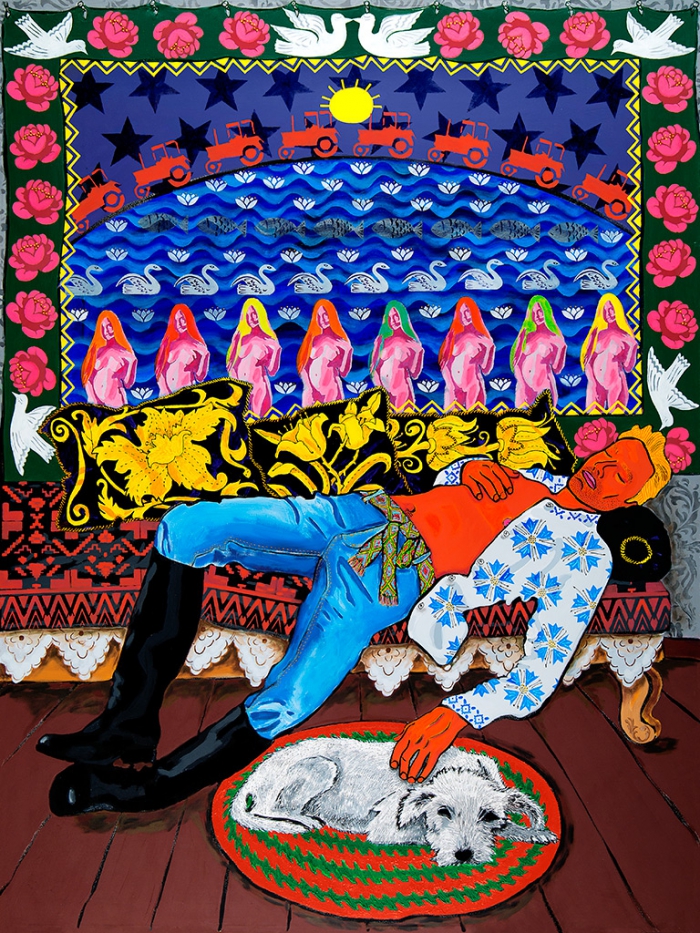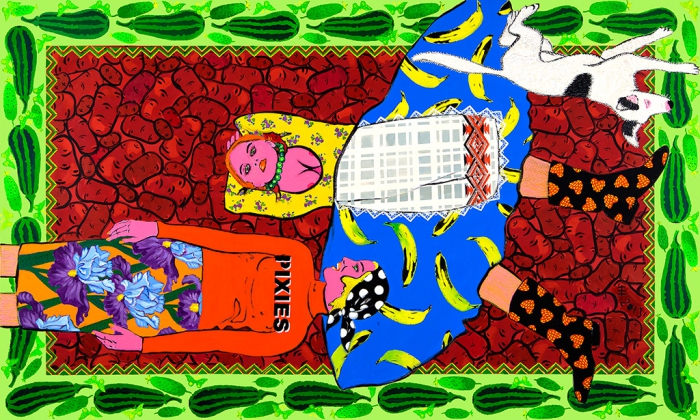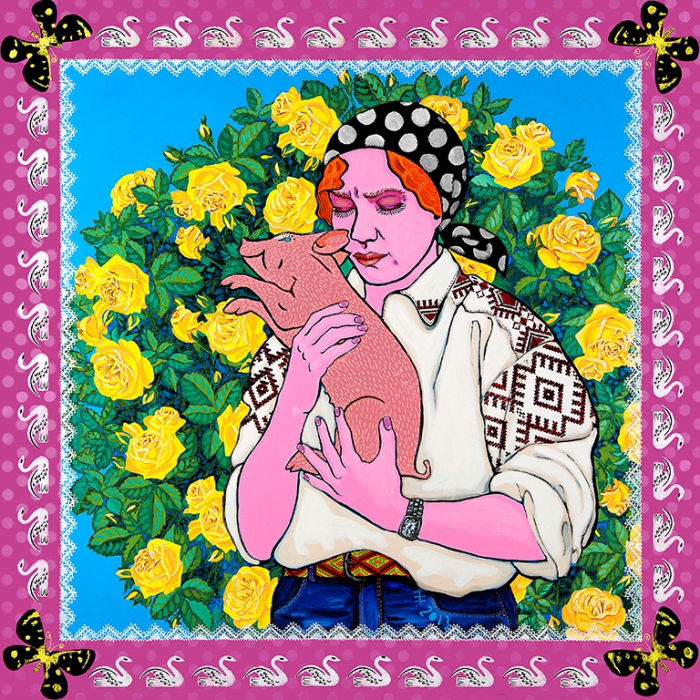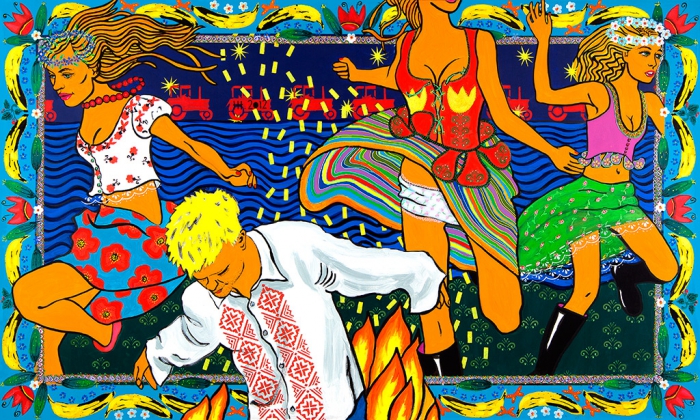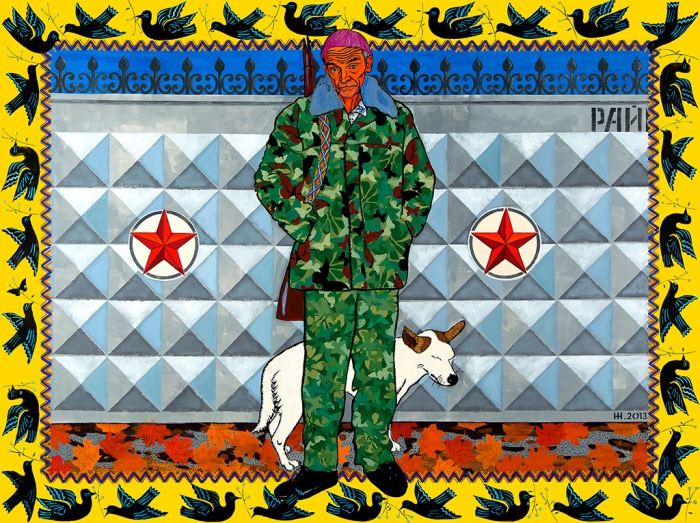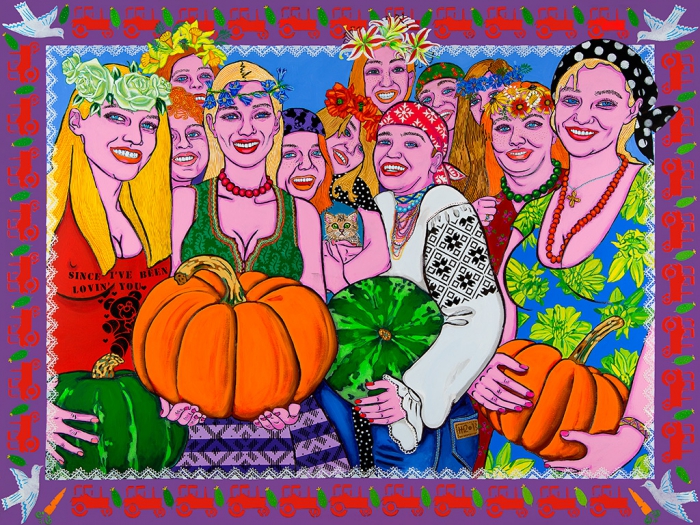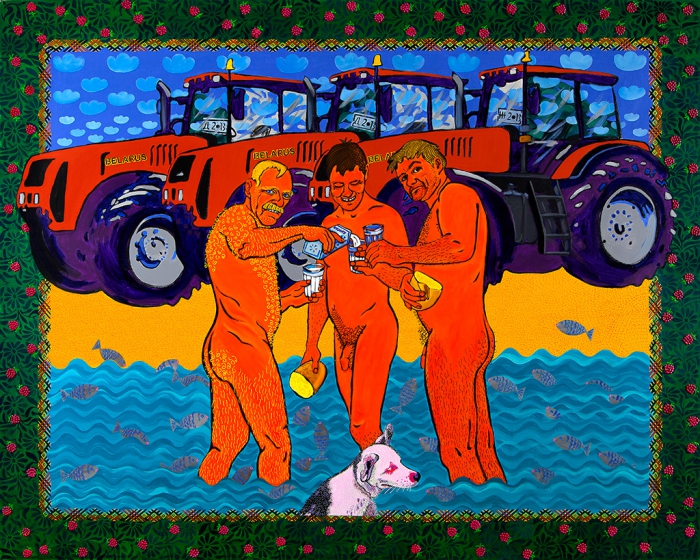2013 • Art project «DAZHYNKI»
Art-project "DAZHYNKI" (i.e. "the final reaping") was presented at October 3, 2013
in Mikhail Savitsky Art Gallery (Minsk, Svobody Sq.,15)
•••
ARTWORKS FROM THE PROJECT:
Salvation (Hall of Fame)
tempera, acrylic on canvas
150х200 cm
2012
Thick green stalks of the tired rapeseed fields lie on each other, combed in different directions, like a green bearskin near the fireplace.The hot July sun doesn't penetrate under the tight "tent". Endless green sea stretches facilely to the reel of the roaring combine.
However it's much quieter in the cabin, you can only hear the discordant rhythm of the threshing system, but if you look at the rear glass, you can see how a peaked hill of brown bread if growing fast in the bunker.It's our Belarusian brown gold.
The combine is cutting quickly the green "tent", leaving the last strip of land.At the right and at the left there is naked and already dry yellowy-brown clay with the storks walking on it. Then somewhere in front a small bird with sharp wings is hopping off.
A minute later all is clear: little yellow fluffy balls are trying to escape from storks.Their mother-duck left ducklings in the face of impending disaster.
The assistant of combine machine driver is jumping on the move and scares the storks who are leaving unwillingly their prey. Ducklings are running very quickly, and when the assistant is catching up - dramatically change their direction and get exactly under his feet, and then being caught,are trying to bite with their weak beaks and getting under the seat in the corner among wrenches and fire extinguishers.
/ Georgy Kapustnikov, 2013 /
Palesse
tempera, acrylic on canvas
150х200 cm
2012
It is believed that the storks's legs in the process of evolution will soon become of the same length as for example the ducks' ones. Because they don't go through the swamps in search of frogs but only after combines and tractors. They hope to get an easy prey that escapes from under the wheels loosing in panic it's shelter. ( * Palesse - is a region in the Republic of Belarus, former USSR )
Сhanterelles
tempera, acrylic on canvas
150х200 cm
2012
Of course, to picking mushrooms is much nicer than to check and clean them...
In Peace (This artwork was made under the impression of the poem "Over the river in peace" by Yanka Kupala, y.1911)
tempera, acrylic on canvas
150х200 cm
2012
|
Над ракою ў спакою |
Перастала дзяўчына Зь ненаглядным страчацца. Бедавала зязюля, Што каліны ня стала; Бедавала матуля, Што дзяўчына ўсыхала. Па рацэ гналі хвалі Ўдаль галіны каліны; Людзі ў рэчцы шукалі Самагубкi дзяўчыны ... Над ракою ў спакою Зацьвіла зноў каліна; А ў зямельцы пад ёю Спала наша дзяўчына. |
/ Я. Купала, «НАД РАКОЮ Ў СПАКОЮ», 1911 /
Salt of the Earth
tempera, acrylic on canvas
200х150 cm
2012
For a long time, probably since the collective farms were formed, the harvesting machine operators have been getting lunch right in the field at different types of field kitchens. But somehow the artists love to represent "a hot afternoon" traditionally. They portray how a woman brings her man a lovely package, so called "tormozok" — some kind of a pack up lunch.
This work initially was called - "Hot Noon." But after the "young" scattered salt in a moment of passion another name appeared...
Runaway Alesya
tempera, acrylic on canvas
150х200 cm
2013
She ran away not from the bison but from the her own groom. The plot is international story about a runaway bride. Just Alesya ran to the forest and met the Bison there.
Young Agronomist
tempera, acrylic on canvas
90 x 200 cm
2012
That's such an agronomist ...
Milkmaid
tempera, acrylic on canvas
90 x 200 cm
2012
Of course now there are farms where a milkmaids don't work any more. The machines are doing everything. Today it is admirable. But one day they (milkmaids and cows) or at least some of them I think, will miss each other.
Cherry Jam
tempera, acrylic on canvas
150х200 cm
2013
Almost every one of us, sometimes even men, at least once in life had to get pips off cherries to make cherry jam.
The juice splashes in different directions. Fingers stick together, bees and wasps attack.
Strength and patience run out, but cherries are still there.
A cat might think — would be better if they cleaned the fish.
Children of a Corn
tempera, acrylic on canvas
150х200 cm
2013
One ranger told us that on the fields that are near forests,especially protected ones, the corn is planted especially for wild boars. So if you're going to get the the corn from the field do not go too far because you can meet up with boar's mum :)
Wild Strawberries Field
tempera, acrylic on canvas
170x200 cm
2013
As you know, in the past weddings were organised after the completion of all agricultural task (after Dazhynki).
My wedding is on a strawberry field, but strawberries are ready only in early summer. So here, of course, I lied for a little bit :) But all the rest is true.
And the strawberry tree is true too.
The Dream of a Tractor Driver
tempera, acrylic on canvas
200х150 cm
2013
On self-made belarussian traditional carpets called "malyavanki" folk artists painted the paradise dream.
They painted something that they had never seen before: unusual flowers, palm trees, lions, tigers, some fantastic birds ...
A tractor driver has laid down for a minute after the lunch. And all these flowers, trees, lions, birds are either in his dream or are simply painted on the carpet.
Potato Pixies
tempera, acrylic on canvas
120 x 200 cm
2013
Some people think that Belarusians do not have enough fries in potatoes.
Miserable
tempera, acrylic on canvas
150x150 cm
2013
In 2013, Belarus African swine fever broke out. On August 29th of that year the Resolution of the Council of Ministers of the Republic of Belarus № 758 was issued and many villagers had to change their traditional lifestyle — to part forever with their pets. Some people sold them alive, others sold the meat, someone ate himself.
But I was told that there were some who said — "I do not sell my friends."
And one said — "I do not eat friends".
Kupalle(Midsummer)
tempera, acrylic on canvas
120 x 200 cm
2012
A folk lore: The yield of cucumbers will be as strong, as the dew on Kupala night. / Kupala night ( Kupalle ) - a traditional holiday of the Slavs on the day of the summer solstice.
The Guard of a Military Office
tempera, acrylic on canvas
150х200 cm
2013
I wish in military enlistment offices of all parts of the Earth it was calm and dull like in Paradise.
Ripe
tempera, acrylic on canvas
150x200
2013
In the olden days in South-East Europe it was matchmakers to first sign a marriage agreement before a bride's parents. However, there were times when a girl refused. Then matchmakers received a pumpkin as a sign of failure.
In some places this occurs nowadays too
Three Tractor Drivers and a Dog
tempera, acrylic on canvas
160 x 200
2013
Did you ever see a dog, going for a bathe alone ? I did not :)
•••
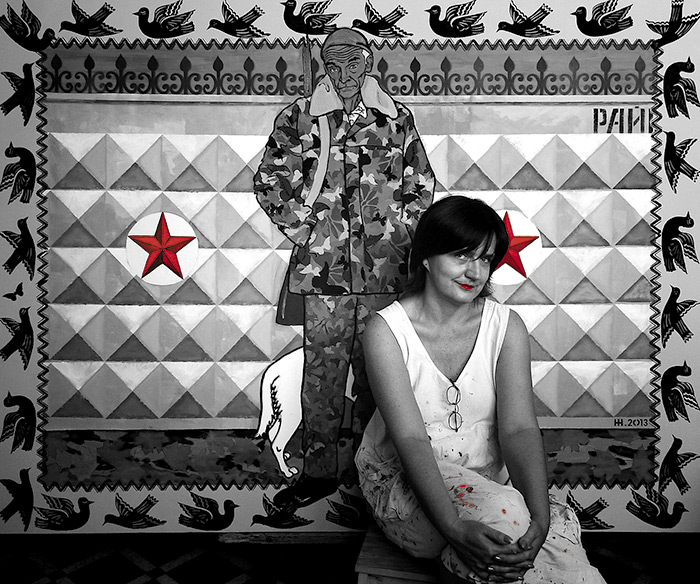
“... Out of all the celebrations on the world,
the festival of harvest is perhaps, the
most important, kind and fair. This festival
being kind and honest to man and nature
is referred differently throughout world
cultures, existing for centuries among all
the nations it has one general and great
meaning — confidence that all the work is
not in vain and and we can sum it up.
Even if the work was hard and still
has results, it brings joy and confidence, and
confidence creates hope and faith in better
tomorrow. It gives the power and meaning
of life.
My field is my workshop and this exhibition is my personal “Dazhynki”. I didn't choose this topic - the topic chose me. It's possible to say that now I know my real national identity through understanding of my past....
In the 1990’s right after “Academy”
(Belarussian Academy of Arts)
I worked a lot with a national stage costume.
I will always be grateful to Vladimir Mulyavin
who was my first customer and who gave me
freedom to do what I wanted. This “planted
the first seed in the soil although the seed
wasn’t ready at that point”. As time went on
after “Pesnyary” I worked with
State Folk Choir “Belyya Rosy”, “Krupitskiya muzyki” and with many simple , but very honest and admiring folklore amateur groups, without doubt also influenced the process of cultivation of the “seed” but at that time didn't have the idea. Then there was a period of the theatre, cinema and television. There were meetings with many new people, many illusions and disappointments sometimes...
Another reason for my national identity that became clear to me is the fact that my mother was born and brought up in Poles'ye, which is now a prohibited area. In 2011 me and my son visited that area and very clearly felt connected to it, despite the fact that we were born and brought up in the city. I realised from visiting Poles'ye is why I have such a thirst for bright colors. It's considered that Belarussian colours are dull and grey because the lack of the sun with only 50 sunny days in the year. But there is such a blue sky there, white sand, purple shades, green moorland, sunset, orange sand dunes among pine trees and beautiful vibrant flowers. It is impossible to give a name to the color of a simple meadow flower growing on the sand, better than any tropical fuchsia! All the variety of colours from the country people were bringing into their houses, to embroidery, weaving and painting.
Some elements, technical and compositional techniques of “malyavanki” I used in my “DAZHYNKI” adding more colours than before. On the paintings you can see beautiful and kind Belarussians, their lifestyle, how they work and rest, young and elderly, big and little, happy and occasionally sad. Because even in heaven it is probably sad sometimes. But still there is place there for irony and self-irony, that we all need sometimes like we need the sun...”
/ Janna Kapustnikova, 2013 /
•••
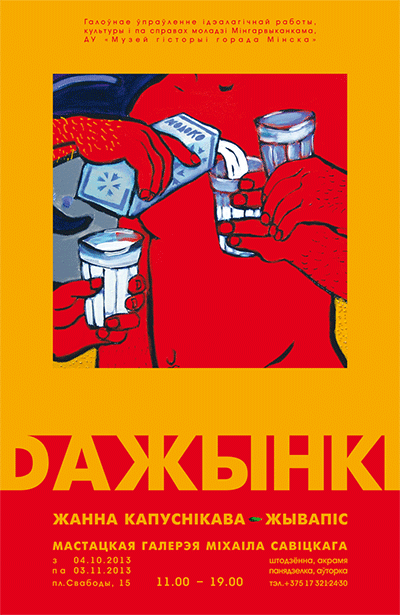
You, metropolis resident, carrying all these gadgets, looking at all that glossy screens while walking, running, eating, talking...
When was the last time you saw a live cow?
Or at least a tractor driver?
When was the last time you saw a milkmaid?
When did you carefree, being not in a
hurry, lay in a fragrant grass looking at the
clouds and smelling cornflower?
Вut somewhere all this exists:
cornflowers, tractor drivers, and a black
greasy earth, and the noise of combines,
going steady in a row through a yellow sea.
Somewhere exists also the smell
of fresh milk... And stock flying over the
morning meadow.
Just have a look — all is here.
Perhaps the reality of rural everyday
life do not look quite like the one on these
canvases.
But who can deny the artist’s right to
see in his own way? Who can deny his right
to create an own world?
*
Nearly twenty paintings of the artist
Janna Kapustnikova make a project called
“Dazhynki”. The artworks were carried out in
a completely different from the mainstream
of today’s painting style — not without a
noticeable effect of Belarusian traditional
carpets “malyavanki”, and filled with such
a powerful life-giving energy that it seems
possible to break the canvas cucumber.
Аnd bite with a crunch, and eat.
Just like that, without any salt.
And eat it with a milk...”
/ Julia Dobrovol'skaya, 2013 /
•••
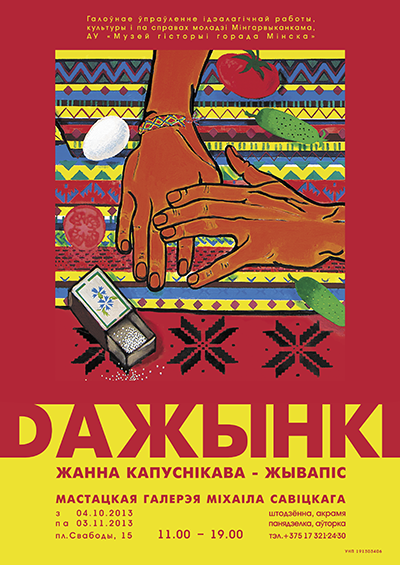
"In the art project of Jeanne Kapustnikovoj" DAZHYHKI "on large canvases depict scenes of rural life, mood and image are not always consistent with the overall vision of them residents of the metropolis. These shared views amazing not much — for their own daily bustle we are not always able to see sincere human joy and beauty. Series «DAZHYHKI» Jeanne is a kind of Utopia, in which it invites the visitor to the exhibition and bustle about such concepts to remember. And the elements of irony and self-irony in the works, in addition to its own picturesque techniques of the artist — is that in her opinion the strength and shape of the Viewer, which can help in this.
For most people the benefits of
society’s transition from one stage to
another one without previous features and
relationships have never been clear. No
matter if the main generator of the utopia
is a philosophical, scientific or economic
institution. The obvious immediate benefits
of the next utopia involves a push to
development but does not always guarantee
the attainability of these benefits. One of the
reasons that makes a person to change his
life and look for happiness somewhere else
is disappointment in the past. People get new
illusions and forget their family, national and
human traditions.
In metropolitan areas the generations
of people who never walk anywhere apart
from aspahalt, even in Wellingtons, live.
The growth of cities on the planet and the
benefits that it promises are causing at the
moment only a threat to natural resources
and degradation of human relations. In the
post-industrial era such values as friendship,
care, beauty, tenderness and love are not
taken into account due to the attempt to
systematise the factors contributing to
the illusory benefits in the long term .
Gradually going out of fashion these values
are exploited to promote economic and
social models, but not always taken into
account in these calculations. However,
though being not really even considered
they have always helped people to survive
in difficult times.
The honesty of colours, the brightness
of emotion is the most important thing that
the artist Janna Kapustnikova shares with
visitors. The utopia of her paintings is not
a requiem to village inhabitants of postindustrial
era that according to futurists will
be probably soon replaced by post-human
era. More likely — “DAZHYNKI” is a kind
of monument to those human values that still
exist despite of being exploited by different
social and economic theories...”
/ Juri Bilyck (Lobanov), 2013 /
•••

Based on materials of the project the album of the same name was released in September 2015.
A BIG THANK TO ALL WHO HELPED AND PARTICIPATED IN THE PUBLICATION OF THE ALBUM:
Olga Kovalenko
George Kapustnikov
Yuliya Dobrovolskaya
Pawel Zayats
Matt Day
Svetlana Jinkina
Andrey Bogdanovich
Andrey Novik
Juri Bilyk (Lobanov)/"Michael Adsul′"
•••
materials about this exhibition on other sites:
Interview & about project “DAZHYNKI” in a TV program ARTiSHOCK on TV channels Belarus-3, Belarus-24
About the presentation of album DAZHYNKI in the newspaper "The Literature and The Art"
•••••••••••••••••••••••••••
... But soon the world has changed, and on traditional reproach to the artist: “You are getting too far away from real life!”, — I wanted to reply: “Rather, we are all getting too far from death.”
And it’s true — we used to live as if we will never die. We are careless in deeds, words, thoughts, and do not think that directly or indirectly may affect not only the life around us, but also the death that surrounds us — we got used to it: the life and the death. We do not appreciate neither life nor death. Neither our own nor the stranger’s ...
… November 18, 2015 at the National Center of contemporary arts of the Republic of Belarus has been opened art project “Another Dazhynki”.
•••••••••••••••••••••••••••

